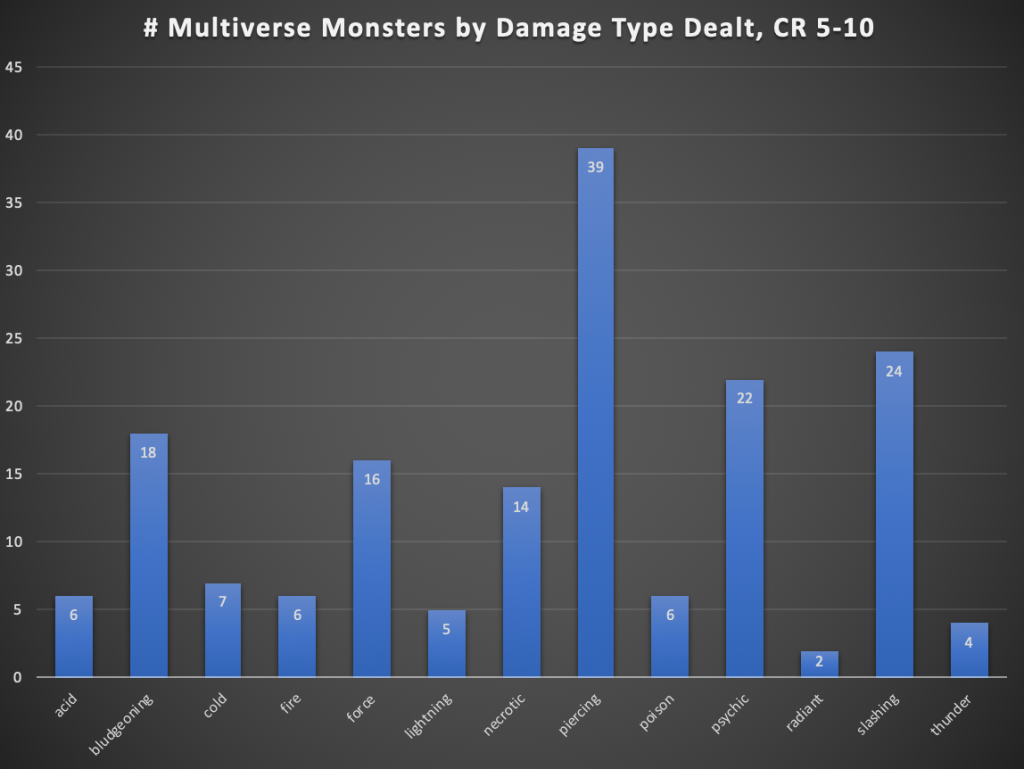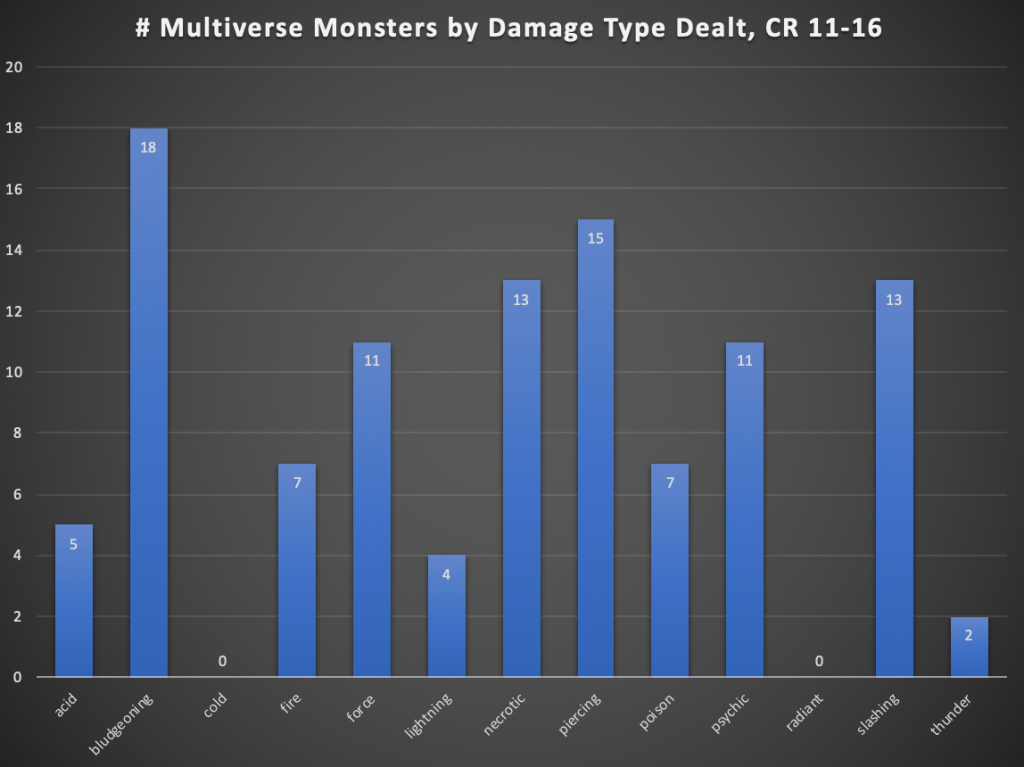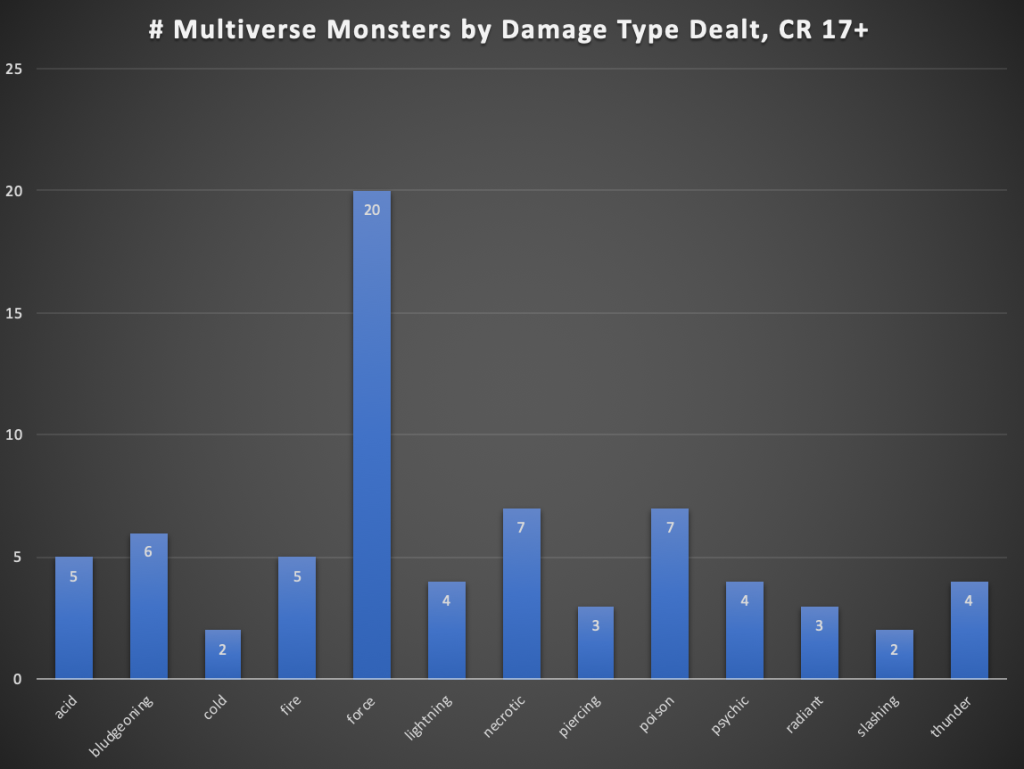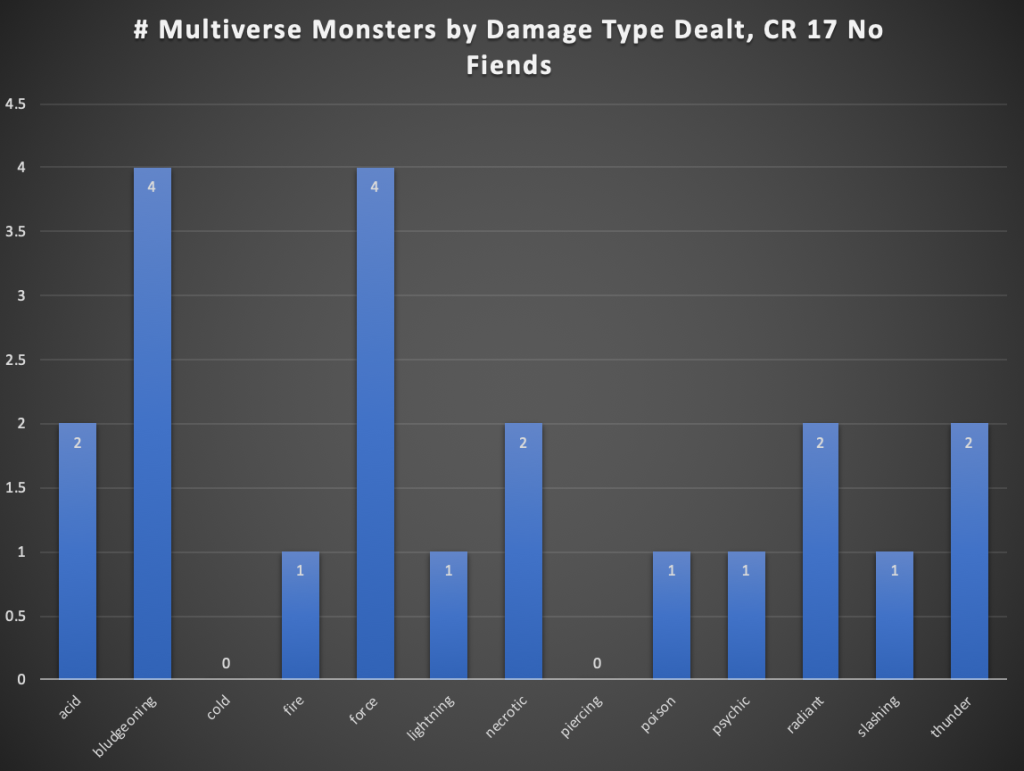The other day I did some Mordenkainen Presents: Monsters of the Multiverse math to figure out whether monsters’ Challenge Ratings had been adjusted. Today I’m switching gears to look at the new monsters from a different angle.
As a lot of people have noticed, one of the big changes in Monsters of the Multiverse is in the damage types dealt by monsters. Force damage, once a rare damage type, is now everywhere. A lot of other melee attacks – poisoned fangs, lightning swords, and so on – seem to do just poison or lightning damage now instead of a mix of physical and energy damage.
Partly, this may be to solve a problem that occurs when monsters fight monsters. A lot of stock 5e monsters that deal bludgeoning, slashing, or piercing damage – “nonmagical” damage – need a way to affect creatures that can’t be hurt by nonmagical weapons. Rather than apply a “Magic Weapons” trait to each high-level monster, these new monsters now deal force or other energy damage instead of nonmagical damage. Of course, like any change, it pulls on various other threads of the game, changing the value of, for instance, items and class features that grant resistance to piercing, bludgeoning, slashing, and force damage.
I thought it would be fun to count up monster attacks and see which damage types reign supreme in the Multiverse. Are bludgeoning, slashing, and piercing useless now? Is force now a force to be reckoned with?
Here are the number of monsters that deal each type of damage, out of 260ish monsters total, in Monsters of the Multiverse. I’m not counting spell damage here: since monsters with damage-dealing spellcasting creatures are rare, that won’t make too much of a difference. You can compare this to the data from the Monster Manual that someone compiled in 2014. (Ideally I’d also compare the new monsters against their old versions to see what changed instead of versus different monsters from the Monster Manual. But after crunching through the new book, I can’t yet face doing the same thing again to the same exact monsters in Volo’s and Tome of Foes. Maybe I’ll get to that after I recover from this round of data entry.)
One kind of surprising finding: sure, at 52, force is way up from 12 force-users in the Monster Manual. But the real champion here is PIERCING. There are more piercing monsters than bludgeoning and slashing monsters combined. More than half the book’s monsters deal piercing damage.
If you’re trying to decide between features that provide different resistances, and you’re using Monsters of the Multiverse to predict the way the Monster Manual 5.5 might go, you can divide the damage types into 3 tiers. Piercing resistance, though rare, is in a class by its own. It even makes you consider an item like the cursed armor of vulnerability, which could grant resistance against piercing in exchange for vulnerability to bludgeoning and slashing. Still not a good deal, but better than you might think.
Below piercing, there’s a tier for medium-common damage types: the already-mentioned bludgeoning, slashing, and force, plus necrotic, poison, and psychic (which gained a ton of ground: only 11 monsters deal psychic damage in the Monster Manual.) In this tier, force is the next most common type after bludgeoning and slashing.
The last tier is for the rarely-seen damage types: cold, lightning, radiant, and, surprisingly, fire, at only 24 (less than 10% of the monsters). For fire, that’s a drop from about 15% of the monsters in the Monster Manual. In other words, apart from poison, the “big five” chromatic dragon breath weapon types are not really generally useful. This is a big change from the Monster Manual, where, after the weapon types, the Big Five were all in the top 6.
Drilling down
This all seems like a reasonable surface reading, but could we perhaps be led astray by confounding variables here? Like, force damage is very common among fiends. Does that alone account for its prevalence? If you’re not going up against the hells, is force resistance still valuable?
Here’s the chart from above with fiends removed from the count.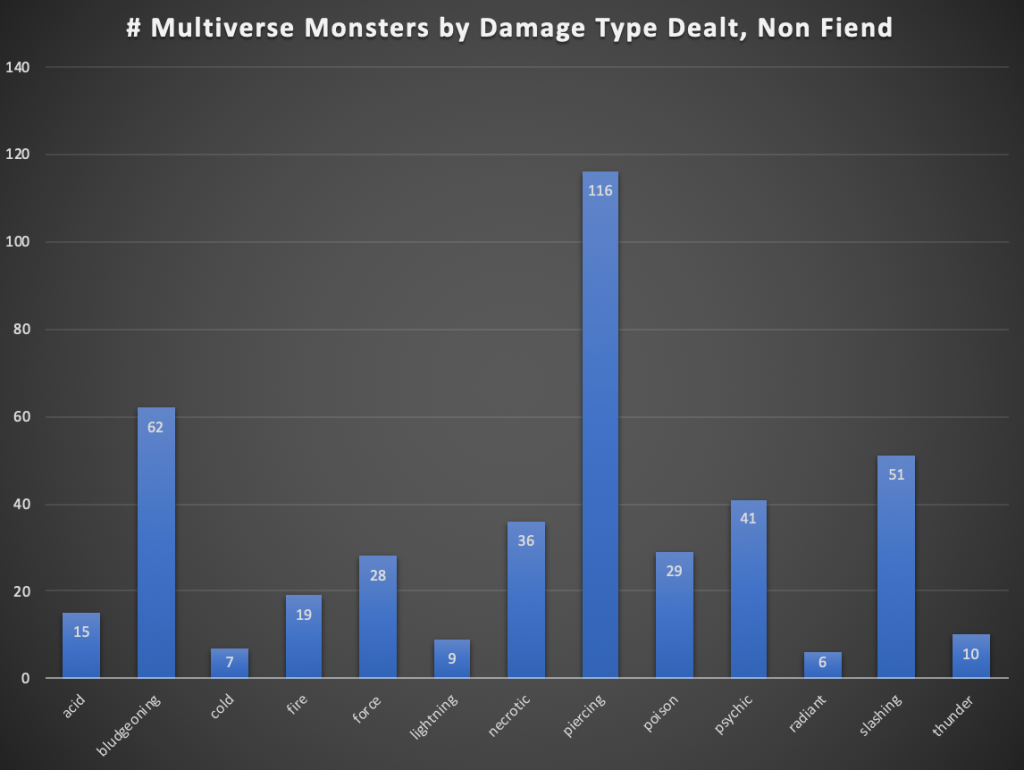
Force is bumped down, but it’s still in the middle tier of usefulness, about as common as poison. Force resistance is still quite useful, although it’s beaten handily by psychic. In general, the chart looks pretty similar with or without the 40+ fiends in the book.
Do some damage types become more common in high-level play? This question was actaully one of the main reasons I started this analysis. If you’re choosing a damage resistance as a class or race feature, are there some “traps” that are only useful at low level or vice versa?
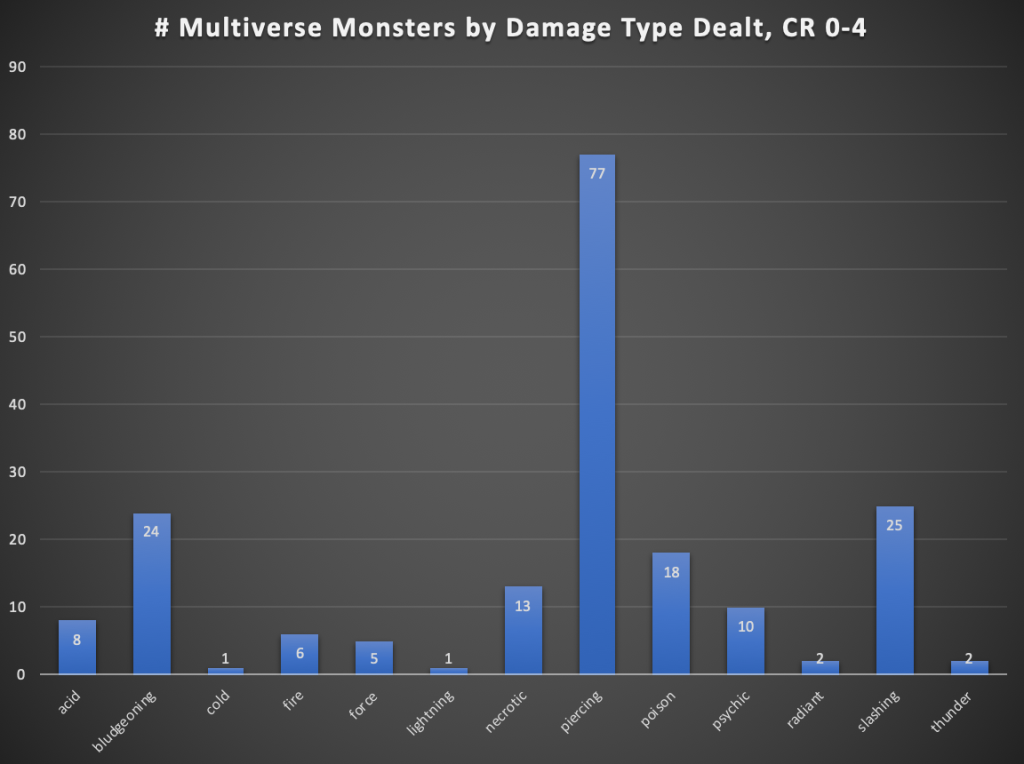
Jeez, look at piercing at Challenge Rating 0 to 4! It has everyone beat by a mile. I would expect claws would make make slashing damage compete better, but at low CR, where a lot of monsters only have one attack, that attack may be a bite. Besides, the Monster Manual might contain more of the basic types of monsters with claw attacks.
Poison is also quite well represented. Force damage is rare.
At CR 5-10, around the “sweet spot” levels, the damage type distribution looks a lot like the overall damage distribution, with the difference that poison has really tanked. A star at level 1, it now looks like a trap choice. Conversely, psychic and force damage have really surged.
At mid-high levels, bludgeoning beats out piercing as the most common physical damage type, as the creatures at this level tend to be Huge creatures that swing outsized fists, tails, and tentacles. Piercing and slashing are hanging in there, but force, necrotic, and psychic damage have almost caught them.
At epic level, the nonmagic damage types, piercing, slashing, and bludgeoning, disappear into the pack. Here’s where force damage makes its move. Of the 25ish monsters of CR 17 or higher, 20 deal force damage. At this level, investing an attunement slot into a brooch of shielding, an Uncommon item, is probably a good move. On the other hand, a barbarian that gains resistance to bludgeoning, piercing, and slashing damage isn’t getting as much bang for their buck. There are a total of 11 monsters that deal B, P, or S damage, with bludgeoning continuing to be the strongest option. All in all, about half as many monsters deal the nonmagic damage types as deal force damage. I bet this trend continues when the Monster Manual is revised. If you’re interested in D&D’s end game, that’s worth keeping in mind.
It might be worth looking at one more chart. Are fiends confounding us again? What if you’re fighting epic non-fiends?
There are only 10 non-fiend monsters of CR 17 or higher in Monsters of the Multiverse. From this small sample, it seems that force is tied with bludgeoning, with 4 of 10 monsters dealing each damage type. There’s only one slasher, and piercing is now nonexistent. Is this your king?
Takeaway
My big takeaway is: people are right, bludgeoning/piercing/slashing are nerfed and force is boosted in Monsters of the Multiverse – especially at high levels. But also the other damage types are rerolled a bit: the dragon-breath types are not well represented, and psychic damage is huge now too. If psychic damage were a stock, I’d say buy it now.
Here is an excel with my raw counts, if someone wants to slice up the data otherways, or add the data from Volo’s and Tome of Foes.


